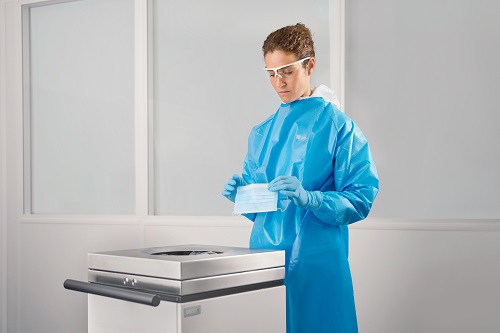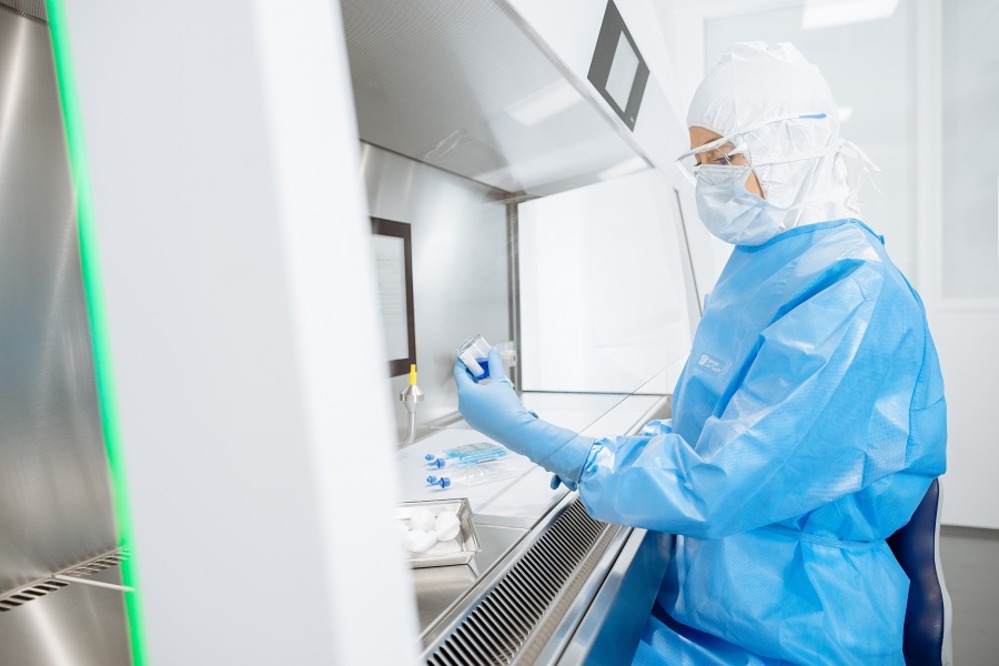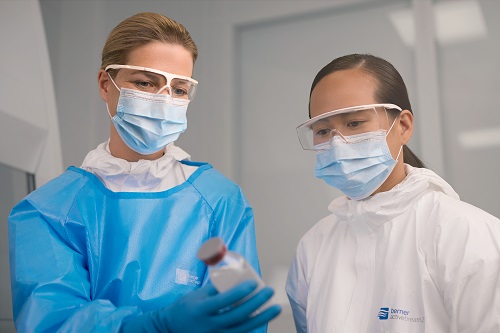Clean or not clean? Cytostatics preparation in an isolator section
The equipment combination used should enable the user to perform preparatory work, such as the disinfection of vials, already in a clean environment. All the required materials were to be introduced into the isolator from there. Accordingly, the isolator line used consisted of a cytostatic isolator as the central manufacturing containment, as well as a safety cabinet for cytostatic drugs for the pre-treatment of the required materials (Figure 1). The units were connected via a ventilated transfer lock. A second, identically constructed airlock was used to remove the finished preparations and to dispose of used auxiliary materials. In accordance with the hazard potential of CMR drugs, the isolator and the airlocks were operated under negative pressure. The working environment outside the isolator section corresponded to GMP purity class D in terms of a worst-case scenario.
During the manufacturing simulation, typical transfer steps such as the removal and injection of small volumes of solution were carried out. Two persons were involved in the overall process - an experienced PTA as the "manufacturer" and a "preparer" (Figure 2). The procedure was based on an established method for microbiological manufacturing control in pharmacies [1]. In the course of production, a total of 120 infusion bags were filled with sterile nutrient solution (Figure 3). For this purpose, 960 defined manipulations were carried out in 60 filling runs, which were not allowed to lead to contamination of the nutrient solution at any point in the preparation process. To evaluate the aseptic working method, the filled infusion bags were incubated and visually checked for germ growth. The microbiological contamination of the work area was also checked with the help of sedimentation plates and swab plates.
Die Ergebnisse der mikrobiologischen Prozesskontrolle waren eindeutig: In keinem der befüllten Infusionsbeutel konnte nach der Inkubation Keimwachstum festgestellt werden. Bis auf eine Ausnahme (ein Keim im Übergang zum D-Bereich) blieben auch alle Proben des Umgebungsmonitorings erregerfrei.
Damit konnte nachgewiesen werden, dass auch unter "A-in-D"-Bedingungen eine aseptisch einwandfreie Parenteralia-Zubereitung möglich ist. Die Arbeiten zeigten allerdings ebenfalls, dass es bei Verwendung von ausschließlich mit Luftspülung betriebenen Schleusen empfehlenswert, wenn nicht gar zwingend erforderlich ist, eine vorgeschaltete Sicherheitswerkbank als reinen Vorbereitungsraum zu nutzen. Nur so ist gewährleistet, dass arbeitsfertig bereitgestellte Materialien nicht erneut der relativ unreinen D-Raum-Umgebung ausgesetzt werden.
The implementation and evaluation of the process validation not only provided interesting findings with regard to the required hygiene. The limits of tried and tested working procedures also became apparent. Work processes that had previously proven themselves when using a safety cabinet had to be adapted to the conditions in an isolator. The limited space and visibility compared to a safety cabinet, as well as more labour-intensive disinfection and transfer processes, required even more detailed process planning in order to comply with previous preparation times. All in all, a sensibly configured isolator therefore represents a cost-effective and safe alternative for the preparation of cytostatics, even if - especially with high production volumes - practical limitations must be expected. A detailed description of the production simulation and its results can be found in [2].
[1] Baumann, L. and Maurer, J. Retrospective revalidation. The key to microbiological validation of aseptic manufacturing. Hospital Pharmacy 2003; 11: 471-479.
[2] Klein, M. Knetsch, H. and Baumann, L. Aseptic manufacture of parenterals in an isolator line. Hospital Pharmacy 2013; 9: 431-438.

 Deutsch
Deutsch
 English
English


